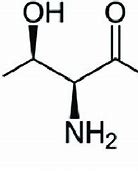
L-Threonine adalah asam amino esensial yang diperlukan untuk pertumbuhan dan perkembangan hewan yang tepat. Seperti L-Lysine, hewan tidak dapat memproduksi treonin secara endogen dan harus mendapatkannya dari makanannya. Treonin terlibat dalam sintesis protein, antibodi, dan enzim, serta dalam mendukung sistem kekebalan tubuh. Menyediakan treonin yang cukup dalam pakan ternak membantu menjaga hewan tetap sehat dan produktif.
Jakarta - 10250 Jl. Kh. Mansyur No.Kav 129-130 Tel. + (62) 21-2253-5010 Mail. [email protected]
Đối với hệ tiêu hóa, L-Threonine sản xuất một lớp gel chất nhầy bao phủ để bảo vệ đường ruột. Chất nhầy có tác dụng như hàng rào để tiêu diệt các enzyme tiêu hóa. Axit amin này phát huy tác dụng bảo vệ của hàng rào chất nhầy của ruột. Một số nghiên cứu chỉ ra khi nồng độ threonine lớn sẽ được sử dụng để tổng hợp protein đường ruột. Vì vậy, để cải thiện sức khỏe đường ruột, chúng ta nên ăn nhiều thực phẩm chứa threonine.
Để tăng cường hệ thống miễn dịch, chúng ta cần cung cấp đủ Threonine cho cơ thể. Trong cơ thể, tuyến ức sử dụng axit amin để tạo ra tế bào lympho T, các tế bào T, chúng có tác dụng chống lại nhiễm trùng bên trong cơ thể.
Chức năng của Threonine có thể cải thiện co thắt cơ bắp. Đã có một số nghiên cứu cho rằng nó có lợi cho các triệu chứng của ALS hay bệnh Lou gehrig.
Hoạt chất glycine được sử dụng để điều trị triệu chứng co cứng vì L-threonine đã được đánh giá về khả năng cải thiện co thắt cơ bắp ở bệnh nhân ALS và kể cả tình trạng co cứng cũng được cải thiện.
L-Threonine giúp hỗ trợ sức mạnh cơ bắp và xương vì collagen và elastin cần threonine để sản xuất đúng cách vì collagen là loại protein dồi dào nhất trong cơ thể. Trong nhiều bộ phận của cơ thể như cơ bắp, xương, da, mạch máu, gân và hệ tiêu hóa đều có L-Threonine.
Threonine đóng một vai trò quan trọng đối với sức khỏe của xương và cơ bắp vì nó sản xuất collagen. Hoạt chất glycine từ threonine, proline và hydroxyproline có tới 57% lượng axit amin trong collagen, vì amino acid này là tiền chất của glycine, nó cũng được sử dụng trong quá trình sinh tổng hợp creatine. Chất này có chức năng cung cấp nhiên liệu cho cơ bắp để sửa chữa thiệt hại.
Threonine cũng cho phép chức năng elastin phù hợp vì elastin là một loại protein có trong mô liên kết cho phép gân, da đàn hồi.
Một công dụng khác của threonine là giúp ngăn ngừa gan nhiễm mỡ, vì loại axit amin này có thể ngăn sự tích tụ chất béo ở gan. Threonine có chức năng chuyển hóa, điều chỉnh chất béo giúp cho chức năng lipotropic.
Trong quá trình trao đổi chất, các hợp chất liptropic hoạt động để phân hủy chất béo. Quá trình này sẽ không thể diễn ra nếu không có axit amin threonine, methionine và axit aspartic. Vì vậy nếu thiếu L-threonine có thể bị gan nhiễm mỡ nặng hơn có thể bị suy gan.
Có thể làm giảm bớt lo âu và trầm cảm nhẹ.
Các nghiên cứu cho thấy sự thay đổi Nồng độ axit amin trong huyết thanh như serine và glycine có liên quan đến chứng trầm cảm lớn điều này đã được một số nghiên cứu chỉ ra. Các axit amin này lại cần threonine để tạo ra chúng.
Threonine là tiền chất của glycine, chất này hỗ trợ sức khỏe nhận thức và có thể làm dịu thần kinh. Vậy nên nó được bổ sung để giảm triệu chứng lo lắng và trầm cảm. Ngoài ra, Glycine có công dụng cải thiện tâm trạng và giấc ngủ cũng như cải thiện trí nhớ.
L-Threonine nó cần thiết cho sự hình thành mô liên kết và chữa lành vết thương, cần thiết cho sản xuất collagen. Bổ sung Threonine bằng cách thông qua thực phẩm giàu Threonine hoặc axit amin T giúp việc chữa lành vết thương, bỏng và các chấn thương khác nhanh chóng phục hồi.
https://indonesiabch.menlhk.go.id/v3/wp-content/uploads/2024/12/5.-Balai-Kliring-Summary-of-Threonine-Eppen_March-24-2-1.pdf
2-Amino-3-hydroxybutanoic acid
InChI=1S/C4H9NO3/c1-2(6)3(5)4(7)8/h2-3,6H,5H2,1H3,(H,7,8)/t2-,3+/m1/s1
Key: AYFVYJQAPQTCCC-GBXIJSLDSA-N
D/L: Key: AYFVYJQAPQTCCC-FGNFWGHYNA-N
L: C[C@H]([C@@H](C(=O)O)N)O
Except where otherwise noted, data are given for materials in their
(at 25 °C [77 °F], 100 kPa).
Threonine (symbol Thr or T)[2] is an amino acid that is used in the biosynthesis of proteins. It contains an α-amino group (which is in the protonated −NH+3 form when dissolved in water), a carboxyl group (which is in the deprotonated −COO− form when dissolved in water), and a side chain containing a hydroxyl group, making it a polar, uncharged amino acid. It is essential in humans, meaning the body cannot synthesize it: it must be obtained from the diet. Threonine is synthesized from aspartate in bacteria such as E. coli.[3] It is encoded by all the codons starting AC (ACU, ACC, ACA, and ACG).
Threonine sidechains are often hydrogen bonded; the most common small motifs formed are based on interactions with serine: ST turns, ST motifs (often at the beginning of alpha helices) and ST staples (usually at the middle of alpha helices).
The threonine residue is susceptible to numerous posttranslational modifications.[4][5] The hydroxyl side-chain can undergo O-linked glycosylation. In addition, threonine residues undergo phosphorylation through the action of a threonine kinase. In its phosphorylated form, it can be referred to as phosphothreonine. Phosphothreonine has three potential coordination sites (carboxyl, amine and phosphate group) and determination of the mode of coordination between phosphorylated ligands and metal ions occurring in an organism is important to explain the function of the phosphothreonine in biological processes.[6]
Threonine was the last of the 20 common proteinogenic amino acids to be discovered. It was discovered in 1935 by William Cumming Rose,[7] collaborating with Curtis Meyer. The amino acid was named threonine because it was similar in structure to threonic acid, a four-carbon monosaccharide with molecular formula C4H8O5[8]
Threonine is one of two proteinogenic amino acids with two stereogenic centers, the other being isoleucine. Threonine can exist in four possible stereoisomers with the following configurations: (2S,3R), (2R,3S), (2S,3S) and (2R,3R). However, the name L-threonine is used for one single stereoisomer, (2S,3R)-2-amino-3-hydroxybutanoic acid. The stereoisomer (2S,3S), which is rarely present in nature, is called L-allothreonine.[9]
As an essential amino acid, threonine is not synthesized in humans, and needs to be present in proteins in the diet. Adult humans require about 20 mg/kg body weight/day.[10] In plants and microorganisms, threonine is synthesized from aspartic acid via α-aspartyl-semialdehyde and homoserine. Homoserine undergoes O-phosphorylation; this phosphate ester undergoes hydrolysis concomitant with relocation of the OH group.[11] Enzymes involved in a typical biosynthesis of threonine include:
Threonine is metabolized in at least three ways:
The degradation of threonine is impaired in the following metabolic diseases:
JavaScript is required...
Please enable Javascript in order to use PubChem website.
Research of Threonine as a Dietary Supplement in Animals
Effects of threonine dietary supplementation have been researched in broilers.[19]
An essential amino acid, threonine is involved in the metabolism of fats, the creation of proteins, the proliferation and differentiation of embryonic stem cells, and the health and function of the intestines. Animal health and illness are strongly correlated with the need for and metabolism of threonine. Intestinal inflammation and energy metabolism disorders in animals may be alleviated by appropriate amounts of dietary threonine. Nevertheless, because these effects pertain to the control of nutrition metabolism, more research is required to confirm the results in various animal models. Furthermore, more research is needed to understand how threonine controls the dynamic equilibrium of the intestinal barrier function, immunological response and gut flora.[20]
Foods high in threonine include cottage cheese, poultry, fish, meat, lentils, black turtle bean[21] and sesame seeds.[22]
Racemic threonine can be prepared from crotonic acid by alpha-functionalization using mercury(II) acetate.[23]























